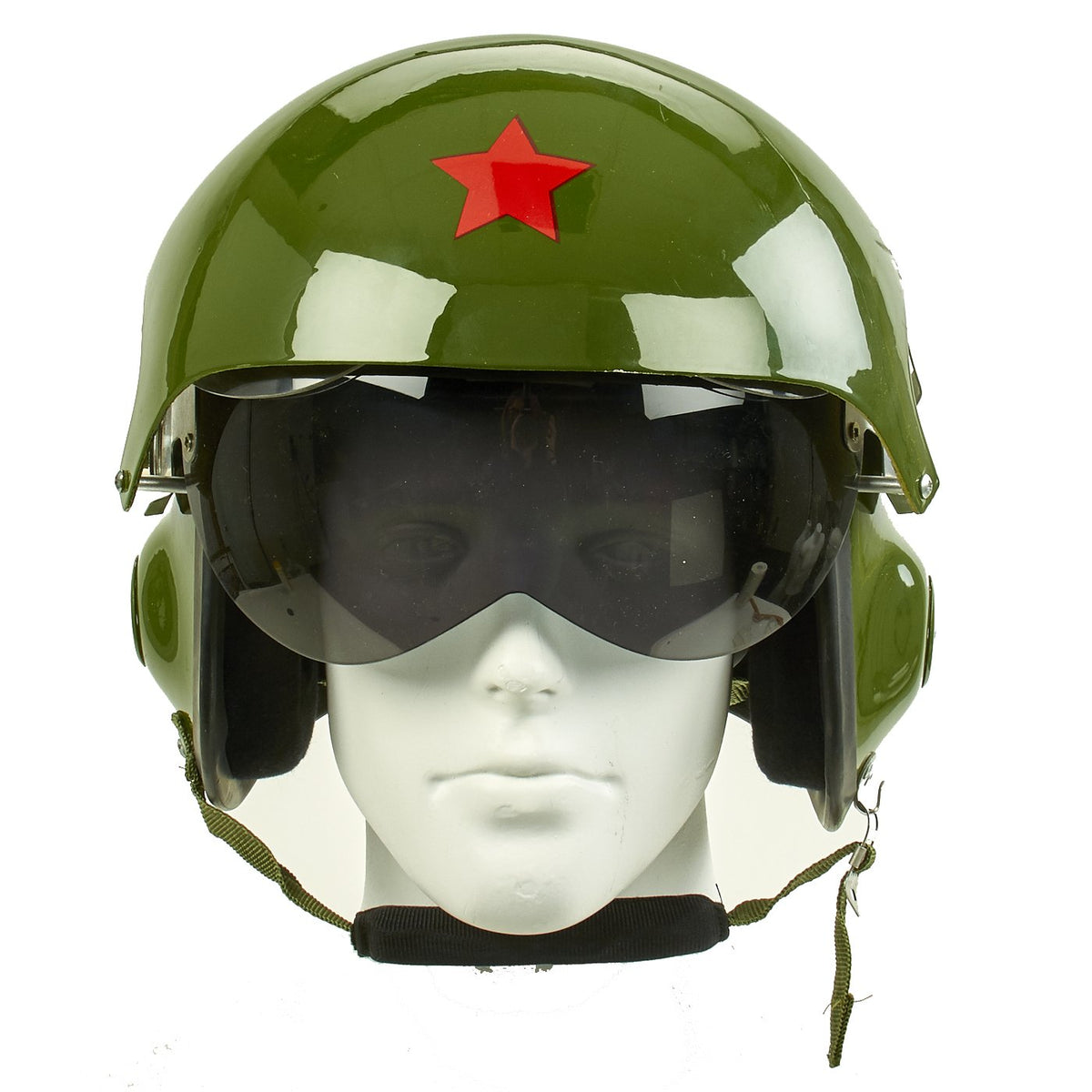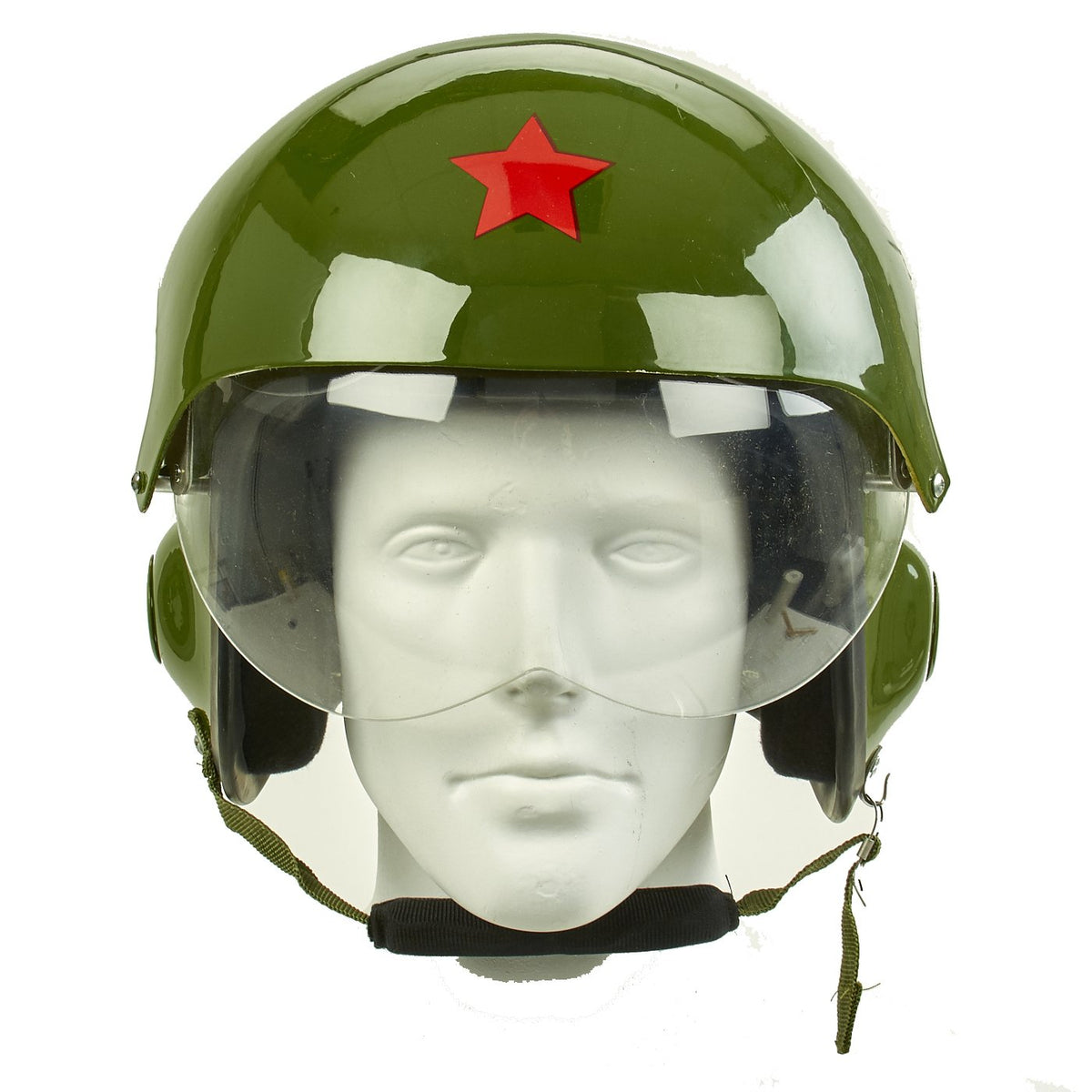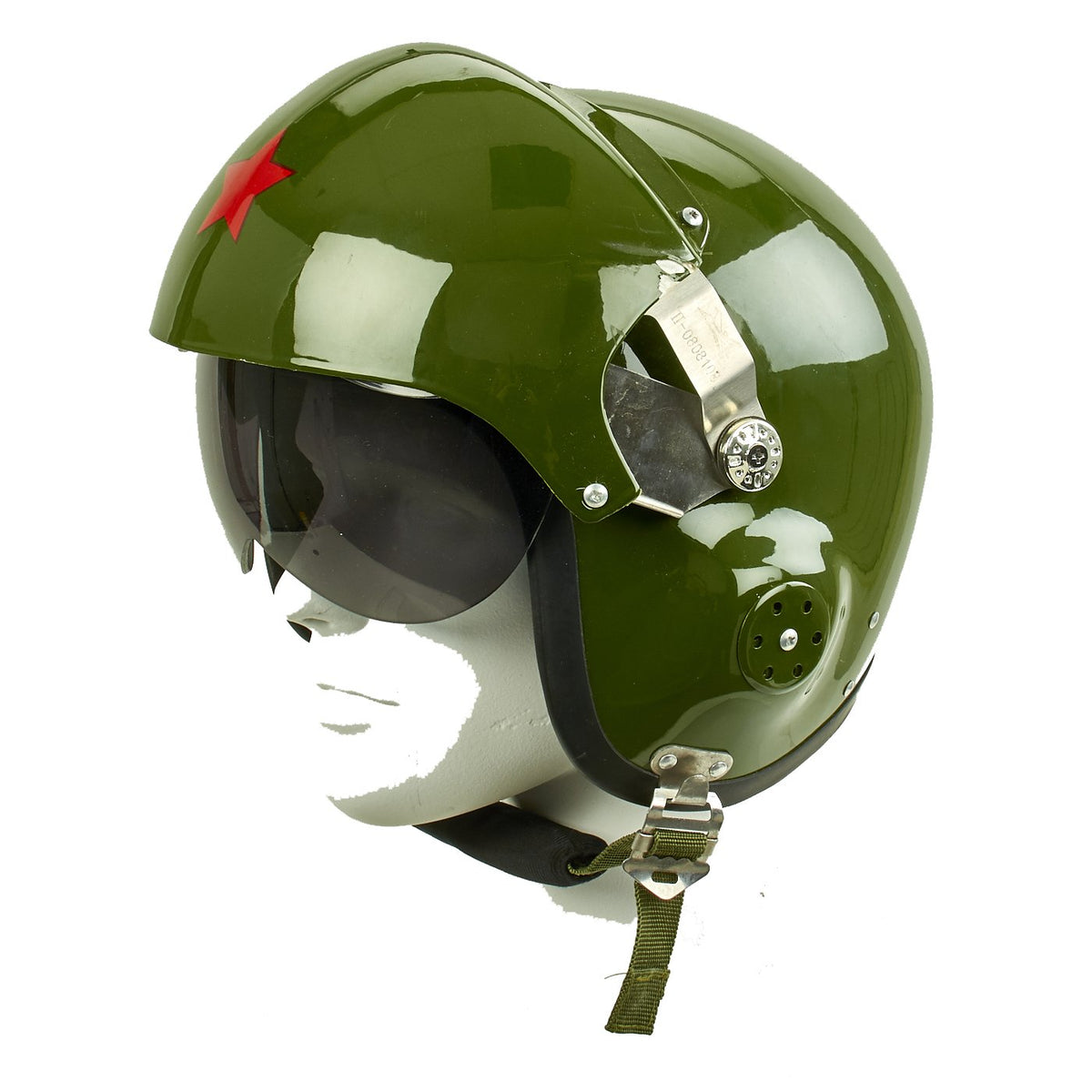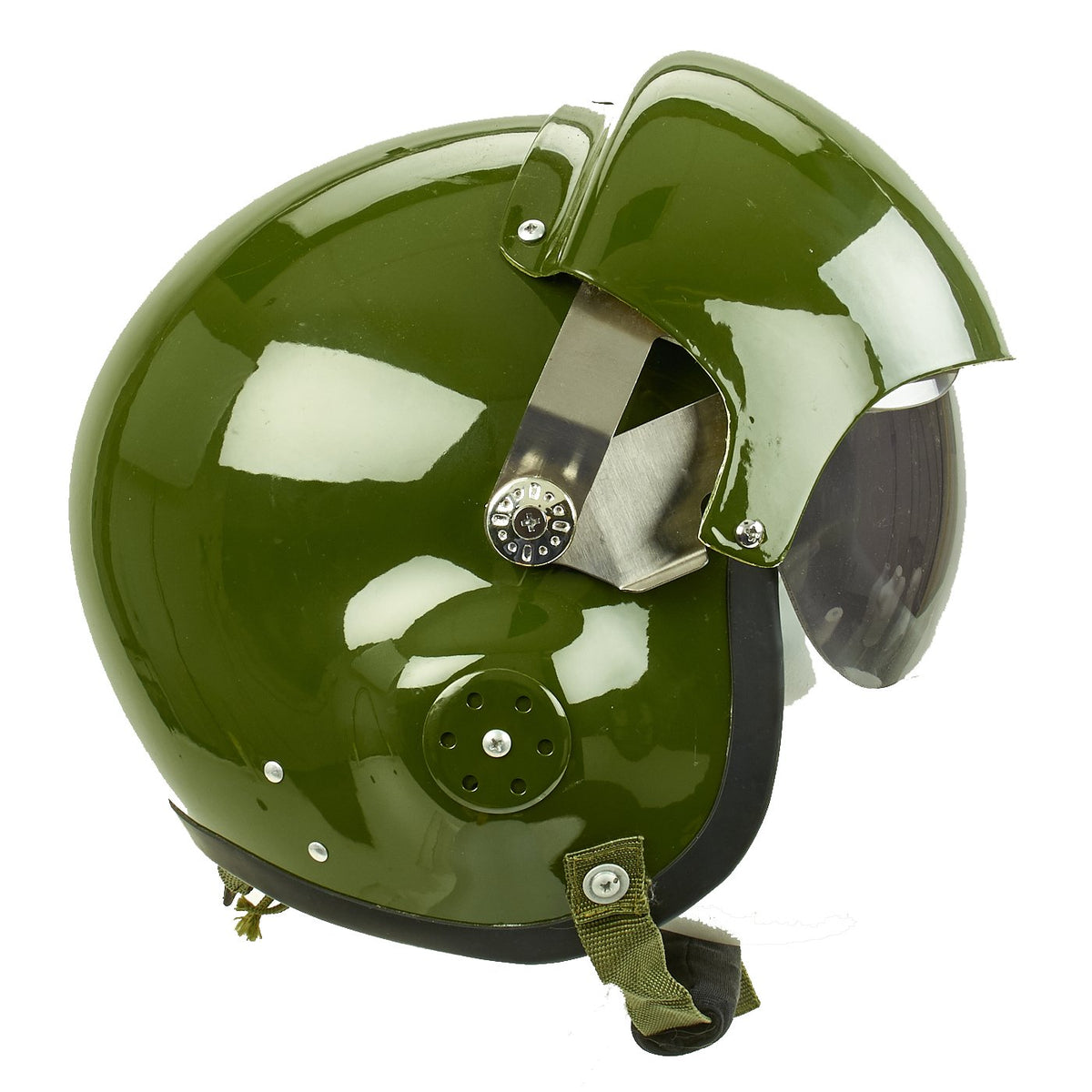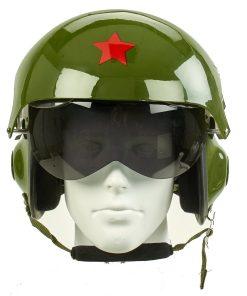Original Cold War Chinese Air Force Tk-2 Flying Helmet Original Items
$ 295,00 $ 118,00
Original Item: Only One Available. This is an excellent condition Chinese TK-2 Flight Helmet which was standard issue for Chinese fighter jet pilots. This flight helmet has a dual visor system with bot clear and tinted retractable visors, felt covered foam ear cups and a web chin strap. Size is approximately a US 7 1/2 (60cm).
History of the Chinese TK-2 Flight Helmet:
In the early 1970s a new Chinese hard shell helmet designated the TK-2 was issued. [Note: the Chinese TK-1 helmet was a pressure helmet based quite closely on the US K-1 and appearing very much congruent with the Soviet GSh-2 pressure helmet, itself inspired by and based upon the USAF K-1 design.]. Jet aircraft performance had improved remarkably in China since the end of the Korean conflict and the higher speed capabilities of new aircraft types mandated improved and vastly more adequate protective pilot headgear for aircrew flying them; although not entirely over and done with, the age of simple leather protective flight helmets was rapidly coming to an end, in China as well as in the west.
In China, acknowledgement of this came into being as the new one-piece hard shell protective helmet known as the TK-2. The origins of the TK-2 are worthy of no small amount of focus here, since it was heavily inspired by American hard shelled protective jet helmets. Originally, when Russia adopted the new ZSh-3 hard outer shell worn over its ShL type leather assemblies for its MiG pilots in the late 50s, quantities of this new Russian design were also introduced to China. [It should be remembered that Russia drew directly upon American protective helmet research for its own jet protective helmets, since before making the decision to keep the existing leather flight helmet and simply use a hard shell over it (e.g. the ZSh-3 design), Russia obtained examples of the American P-3 helmet that were captured by the North Koreans from crashed Sabre pilots and produced an entirely Russian copy of the US helmet and mask (P-3 and A-13A mask) designated the ZSh-2 and KM-24. The ZSh-2 and KM-24 were flown extensively to determine their effectiveness and quantify their technology, but eventually the American one-piece helmet design lost out to the Russian ZSh-3 two-part helmet. When the new hard shell ZSh-3 helmet was offered to China for evaluation and suitability (in the late 50s/early 60s), Chinese PLAAF pilots uniformly rejected the aluminum shelled ZSh-3 as cumbersome, awkward and generally not to their liking. Due to this and adverse economic circumstances then extant in China, a decision was made to continue using the Types 50 and 59 leather flight helmets alone in the early PLAAF MiGs until a more suitable solution was found.]
Meanwhile, several events occurred that had an effect on China’s search for appropriate protective headgear for its MiG-17 (Shenyang J-5 two seat version) and MiG-19 (Jianjiji F-6) pilots. In 1963, a Taiwanese Nationalist pilot flying the NAA F-86F Sabre defected to China. His American issued P-4A flight helmet was soon passed along to Chinese flight test personnel for detailed evaluation and analysis. The results of this close scrutiny of American hard protective helmet technology played a significant part in Chinese plans to develop their own protective hard helmet.
Subsequently, in 1965 a US Air Force F-105 Thunderchief fighter-bomber from the Vietnam theatre was shot down by elements of the Chinese Air Force and the personal flightgear of its pilot were passed along for evaluation similar to that performed earlier on the US P-4A design; the American HGU-2/P type helmet was given to the Chinese engineer who would soon produce the new all-Chinese design known as the TK-2 helmet.
The entirely new Chinese TK-2 ‘hard’ protective helmet that resulted featured the same basic head protection concept as the latest (late 50s) US Air Force and US Navy generation helmets (the USAF HGU-2/P and the USN APH-5), all having a hard fiberglass outer shell lined with a crushable, impact-absorbing foam polymer material (similar to Styrofoam). The TK-2 also featured a left-side manually activated, single shaded sun-visor that was protected from scratching (following the US helmet feature) by a fiberglass housing. Simple clasp-type hooks (not dissimilar to those used on earlier Russian and Chinese leather helmets) were used to secure the chin strap and mask suspension attachments were also of the simple clasp-type design (a rather old technology feature that would remain in use well into the 1980s on Chinese hard-shell aviation protective helmets) . A comparison of the dark sky blue painted TK-2 hard-shell helmet with contemporaneous USAF and USN helmets clearly reveals the American (and Soviet) design influence on the Chinese TK-2, since the TK-2 also featured wind-blast pressure relief orifices in its shell, intended to enhance helmet retention during high-speed ejection (functionally identical to those featured on Russian ZSh-3 outer shells and US HGU-2/P and APH-5 helmets). Foam earphone cushions inside the helmet contained Chinese earphone receiver elements that were linked by a communication cable fitted with the same Soviet DIN 4-pin connector (originally developed and used by the Luftwaffe) for interfacing with the aircraft radio/communications avionics. Visually most distinctive was the prominent Communist red star that was painted on the forward visor cover of the TK-2. [Note: Although a common feature of all Chinese hard protective flight helmets up to the present, none of the Soviet flight helmets have to our best knowledge ever featured a red star emblazoned in this manner, despite apparent popular belief].
The TK-2 helmet remained in use by PLAAF pilots flying newer, faster jet aircraft over an approximate 10 year period while China’s new developing air forces expanded and gained further expanded air combat capabilities. In the mid-1980s an improved version designated the TK-2A flight helmet came into use, intended as a significant upgrade of the earlier TK-2, and although painted white instead of azure blue, at first glance it shared many similarities with its blue antecedent. Slight changes in the later shell areas over the earphone were apparent upon close inspection but the communications cords and connectors remained virtually identical to those used on all earlier Soviet and Chinese helmets. Rather than adopting the well-proven and standardized Soviet KM-32 pressure-demand oxygen breathing mask (or China’s own YM-6504 clone of that mask), China elected to develop and produce its own unique pressure-demand design that was designated the YM-6505 mask. Using a hard green polymeric outer shell, much like the American MBU-5/P mask, the new YM-6505 mask’s rigid external shell contained a green rubber facepiece that featured a face-seal portion lined (as found on the Soviet KM-32 mask) with chamois material. A small diameter hose exited the left side of the assembly to link with an inflatable pressure bladder fitted to the inner occipital portion of the shell to enhance mask retention, using the same principle featured on all Soviet pressure-demand masks. Whereas the older blue TK-2 helmet was originally used with the Chinese YM-6502 demand mask , the newer white TK-2A helmet was issued with the new YM-6505 pressure-demand mask, both items being (apparently) a standardized set-up for Chinese PLAAF fighter pilots. Internally, the white TK-2A helmet was essentially similar to the older blue TK-2, with no substantial protective or safety enhancements apparent upon direct examination. Of note is the fact that despite the relatively late date of the TK-2 and TK-2A helmets, the YM-6505 pressure-demand mask lacked an internally fitted microphone, thus requiring use of the same throat mic (LA-3,4,5 laryngofone) set-up that all Soviet and Chinese helmets had required from the late 40s through the early 80s.
In the early 1990s, two newer and further improved flight helmets came into use, designated the TK-10 and TK-11 helmets, both painted white with the ubiquitous red star on the visor cover. These designs bear very close superficial resemblance to the earlier TK-2A design, being white and featuring similar wind-blast orifices in their shells, and using similar impact absorbing inner cushioning (Styrofoam) features, but gained more sophisticated leather earphone cushioning and interior lining. The most notable improvement in the new TK-10 and TK-11 appeared to be the incorporation of substantially improved oxygen mask retention receivers and bayonets, being virtually identical to those in use on all modern Soviet flight helmets. Situated just inside the helmet shell (following the Russian ZSh-7 example) rather than externally (as on modern US helmets), the new receivers provide a much more secure and modern system for mask retention. Somewhat surprisingly, the communications cords used on the TK-10 and TK-11 helmets remain exactly congruent with and identical to the same classical 4-pin DIN connector standard originally pioneered on German Luftwaffe helmets in WWII!
Along with the new TK-10 and TK-11 (each variant otherwise differing only modestly in terms of communications receivers and their fittings), China introduced several new pressure-demand oxygen masks that bespeak a considerable effort on the part of Chinese R&D to produce an improved and modernized oxygen breathing mask design. Notable among these new masks are the Type YM-9915 and YM-9915G developments. Each is remarkably different in appearance (despite sharing a numerical designation), with the YM-9915 mask featuring a rather awkward and complex arrangement of its main and pressure compensation oxygen hoses that appears intended to offset inertial forces acting on the wearer during high-G maneuvers (this has been done by moving the mask’s center of gravity mass closer to the face and reducing the suspended weight of the hoses in the front of the facepiece: see images for a better idea of this). However, since the masks still used the rather old-fashioned and inelegant pressure compensation valve system inherited from Soviet masks, such an attempt is rendered far more difficult than it would otherwise be, were a more sophisticated combined inhalation-exhalation valve (such as used on the American MBU-5/P, MBU-12/P, and MBU-20/P masks) utilized. One noteworthy aspect of the YM-9915 mask is the fact that for the first time in Chinese mask design, the face seal portion of the facepiece is natural silicone rubber and is not lined with chamois material, as found on all previous Chinese and Russian masks. The main oxygen delivery hose on the YM-9915 mask’s facepiece is also of a green rubber corrugated construction (lacking an integral bonded fabric outer surface, as had been the accepted practice on all prior Russian and Chinese masks).
Analysis suggests that although apparently actually produced and issued to Chinese aircrews (distribution numbers unknown), the limitations of this awkward appearing design may have been quickly recognised and a further development designated the YM-9915G mask was initiated. The latter ‘G’ upgrade design, although still featuring the old Soviet pressure compensating valve component, presents a somewhat radically different appearance from that of the preceding YM-9915 mask. Interestingly, the face seal of the YM-9915G again returns to use of chamois material, but the main oxygen delivery hose and pressure compensating valve both exit from the front of the facepiece in a more conventional manner, presenting a somewhat superficial resemblance to the late 50s introduced American MBU-5/P mask. Both the YM-9915 and YM-9915G masks feature a green rigid polymeric outer support shell fitted over a softer rubber facepiece (as on the MBU-5/P), but both the YM-9915 and YM-9915G masks depart from earlier practice in that the occipital bladder tube exits on the right side of the facepiece, rather than on the left. Further, both masks utilize a new type of ‘T-bayonet’ on each side supposedly intended to optimize mask retention and enhance fitment (it is in fact clearly modeled after the American ‘T-bayonet’ components used on twin-strap MBU-5/P masks). Although a significant step forward (the ‘T-bayonets’), both masks feature rather flimsy and unsubstantial nylon suspension straps that do not interface effectively with the rather too-wide slots provided on the bayonets. Thus, it is again a somewhat awkward attempt to arrive at what the west has long-since perfected with its own offset bayonet/receiver systems (as found on the American MBU-12/P and MBU-20/P masks). Both the YM-9915 and YM-15G masks are fitted with internally mounted microphone assemblies (a first for Chinese masks), eliminating once and for all the need for PLAAF airmen to use the (Soviet type) LA-5 type throat laryngofone. Interestingly, as mentioned earlier, the YM-9915 mask features a new type of non-fabric covered corrugated rubber main oxygen delivery hose, while the newer YM-9915G mask features a fabric-encased nylon hose sleeve that appears much like that used on the Russian KM-35 mask.
One further mask worth mentioning here is the Chinese YM-6512 demand oxygen mask, a mask that replaces the earlier YM-6502 type demand mask and which is most commonly seen in use by PLAAF pilot trainees (this mask is employed at lower altitudes not requiring pressure-demand capability). Using the characteristically green colored polymeric rigid outer shell over a softer green rubber facepiece concept, the YM-6512 mask contains an inner microphone assembly and features a non-fabric coated main oxygen delivery hose (a departure from most other Chinese and Russian masks that have used an external, bonded fabric layer over their corrugated hoses since the earliest days of the KM-16 mask). The YM-6512 (green) mask comes with loop-latch type attachment fasteners (used with older TK-2A and soft leather helmets), while the YM-6512A model comes with bayonets (for use with TK-10/11 type helmets). A newer version of the YM-6512 mask designated the YM-6512G appears to be identical to the earlier green versions and comes with bayonets, but is gray overall in both hard and soft facepiece components.
Another Chinese hard protective helmet design is the Type TK-2C helmet, used exclusively by the People’s Liberation Army Naval Air Forces (PLANAF). Featuring a hard fiberglass external shell painted in gray, the shaded sun-visor uses the earlier TK-2A type left side actuation mechanism, but lacks the former’s external visor cover (thus bearing a superficial initial resemblance to the old USAF P-4B helmet). Internally, the TK-2C helmet retains the simple side-mounted oxygen mask fastening clasps (and chin strap clasp), but has upgraded leather fitting pads and earphone cushions. The communications cords are identical to those used on all earlier Chinese flight helmets. The mask apparently most often used with this helmet is the YM-6512 demand mask, although it can certainly be used with a pressure demand type such as the YM-6504. There is, of course, no occipital bladder fitted, although this too may be mounted in it for appropriate use.
Still another Chinese development for use strictly in the latest Russian Su-27M type air superiority fighter (and in the Chinese produced clone, designated the J-11) are copies of the Russian ZSh-7 helmet and the Russian KM-35 oxygen breathing mask. Designated the Chinese TK-12A (ZSh-7) and the YM-9925A (Km-35), this set of items is replicated to congruently conform to the Russian counterparts. Differing only by virtue of a slightly grayer shade of off-white than that found on the Russian ZSh-7’s outer shell, the Chinese TK-12A helmet is otherwise indistinguishable from its Russian inspiration..at least externally. Internal fittings and appointment also match those found on the ZSh-7 helmet, but a Chinese identification/specification sticker may be found on the lower inside shell, by slightly lifting the lateral fitting cushions. Also, a metal ID plate stating ‘TK-12A’ may be found attached to both right and left oxygen mask receivers on the helmet. Aside from these small identifying characteristics, the Russian and Chinese versions are difficult to tell apart. For its part, the Chinese YM-9925A pressure demand oxygen breathing mask, although functionally identical to the Russian KM-35M mask, is produced in that characteristic dark jade green color (both rubber and hard-shell components) so that the Russian and Chinese masks are immediately identifiable. The YM-9925A mask may also be produced in the same shade of air-superiority gray now favored by the very latest Chinese flight helmets, but further information (other than photographic evidence) on that is lacking at this time. Due to the highly specialized nature of Su-27/J-11 aircraft operations by the PLAAF forces, the TK-12A and YM9915A set of items is almost impossible to acquire outside China (by collectors, for example). When they are, a set of the two items can command a present ‘best price’ cost of approximately US$ 1200!
The very latest Chinese oxygen breathing masks now in use by the PLAAF are the YM-6, the YM-9, and the YM-12 types. Both the YM-6 and YM-9 masks are of the pressure-demand type and are an entirely new development that places them on a technical plane somewhat approximating the American MBU-20/P series (and the Russian KM-36M, one of the latest of their designs). Benefitting from combined study of both Russian and American mask design elements, these new side-hose masks are used with bayonets to attach to receivers similar to those found on the TK-11 helmet. The YM-6 mask seems to be molded from the characteristic dark jade green rubber used on most all previous Chinese oxygen masks, but the YM-9 mask appears to be molded in a newer air-superiority gray colored rubber. The YM-12 mask (dark jade green) is of the non pressure demand type, obviously intended for use at lower altitudes and lacking a pressure-compensating valve component. All three of the new style masks utilize an internally fitted microphone, following the standard western custom and all three masks use a rubber faceseal concept, rather than the prior chamois material approach. The first two masks (YM-6 and YM-9) feature occipital bladder connectors exiting from the left side of the facepiece)
Two further Chinese helmets not previously mentioned are the TK-11B and TK-11C. Although not confirmed, the TK-11B helmet, which features gray shell paint and an uncovered smoke sun-visor (in the manner of the TK-2C PLANAF helmet described earlier), appears to be an upgrade design for use by Chinese People’s Liberation Army Naval Air Forces aircrew. It features interior appointments that match those found in the TK-11 and TK-10 helmets and may or may not have recessed (secured within the shell) oxygen mask receivers (a specimen has not yet surfaced to enable a detailed, close-up examination). The Chinese TK-11C helmet appears to have a light gray outer shell color (with the standard red star) and is purported to be intended for use by rotary-wing aircrew (with boom-mics, etc.). Still a more recent update of the TK-11C design has been designated the TK-11CII helmet. It looks to be quite similar to the TK-11 in almost all of its viewable features and appears also to use common 4-pin DIN type com connectors like all previous Chinese flight helmets. Internal sizing pads, earphone cushions, mask bayonet receivers, and other ‘comfort’ details are also apparently not much changed (if at all). The visor is covered and articulated by the same type of left handed latch system first used on the TK-2A helmet. Not much other information is presently available about the TK-11CII design, unfortunately, although word has it that the TK-11CII helmet is another extremely difficult helmet to obtain from outside China due to its relative newness and present scarcity in production inventories.
Fast Shipping with Professional Packaging
Thanks to our longstanding association with UPS FedEx DHL, and other major international carriers, we are able to provide a range of shipping options. Our warehouse staff is expertly trained and will wrap your products according to our exact and precise specifications. Prior to shipping, your goods will be thoroughly examined and securely secured. We ship to thousands clients each day across multiple countries. This shows how we're dedicated to be the largest retailer on the internet. Warehouses and distribution centres can be located throughout Europe as well as the USA.
Note: Orders with more than one item will be assigned a processing date depending on the item.
Before shipping before shipping, we'll conduct a thorough inspection of the items you have ordered. Today, the majority of orders will be delivered within 48 hours. The delivery time will be between 3-7 days.
Returns
The stock is dynamic and we cannot completely manage it because multiple stakeholders are involved, including our factory and warehouse. So the actual stock may alter at any time. It's possible that you may not receive your order once the order has been made.
Our policy is valid for a period of 30 days. If you don't receive the product within 30 days, we are not able to issue a refund or an exchange.
You can only return an item if it is unused and in the same state as the day you received it. You must have the item in its original packaging.
Related products
Uncategorized
Uncategorized
Uncategorized
Uncategorized
Uncategorized
Uncategorized
Armoured Fighting Vehicles of the World: AFVs of World War One (Hardcover Book) New Made Items
Uncategorized
Uncategorized
Angolan Rebel 1970s era 60mm Inert Display Mortar from Angolan Civil War Original Items
Uncategorized
Uncategorized
Uncategorized
Uncategorized
Uncategorized
Armored Burgonet Helmet & Polearm from Scottish Castle Leith Hall Circa 1700 Original Items
Uncategorized
Uncategorized
Uncategorized
Uncategorized
